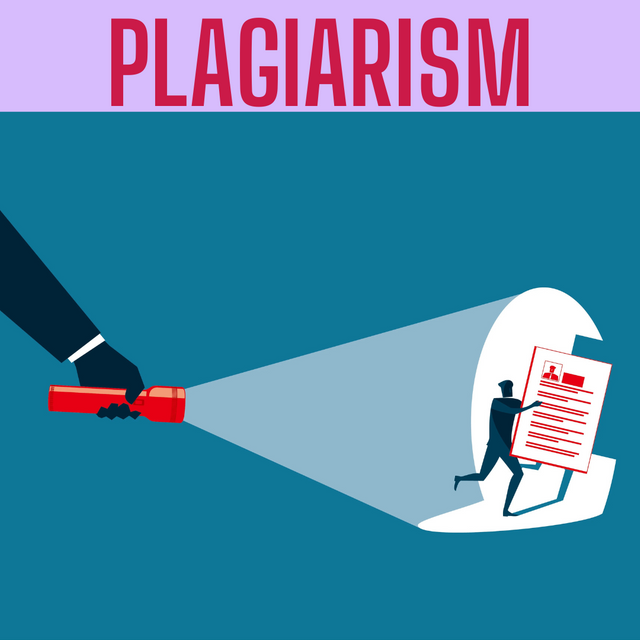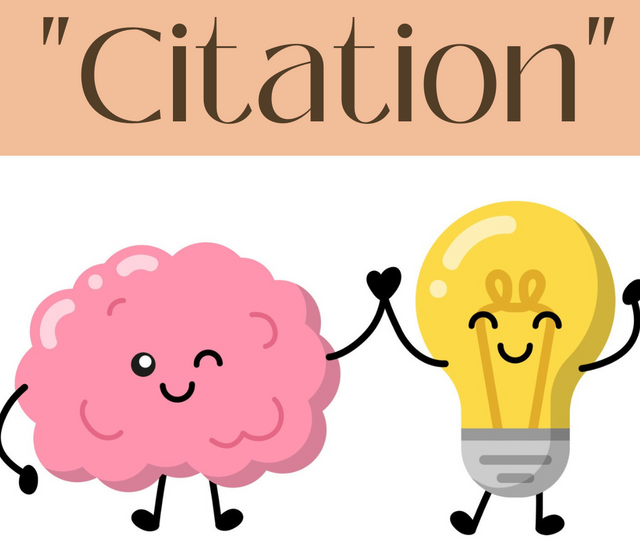Greetings to the Steemit community! I hope you are all doing well.
I'm excited to share that I have achieved two milestones (Achievement 1 & Achievement 2), and now I'm moving towards my Achievement 3 on Content Etiquettes. I'm fully committed to understanding and implementing the best practices for writing high-quality content that will engage and entertain my fellow Steemit enthusiasts.
What is Plagiarism?
Plagiarism is the act of using someone else's work or ideas without giving proper credit or permission. It can take various forms, such as copying word-for-word, paraphrasing without attribution, or using small parts of someone else's work without proper citation. Plagiarism is considered unethical and can have serious consequences, such as legal action, loss of reputation, or academic penalties. It is important to always give proper credit and use proper citation methods to avoid plagiarism.
Types of Plagiarism:
1. Direct Plagiarism
Direct plagiarism is the act of copying word-for-word from a source without attribution. It involves taking someone else's work, such as a sentence, paragraph, or entire document, and presenting it as one's own without acknowledging the original author. Direct plagiarism is considered a serious form of plagiarism and is generally not tolerated in academic or professional settings.
2. Self-Plagiarism
Self-plagiarism is the act of reusing one's own previously published work without proper citation or permission. It can take various forms, such as submitting the same paper or parts of a paper to multiple classes, or submitting the same article to multiple publications without proper attribution. Self-plagiarism is generally considered unethical because it can be misleading to readers and can undermine the integrity of the publication or academic process. In some cases, it may also violate copyright law. It is important to always properly cite and acknowledge any previously published work, including one's own, to avoid self-plagiarism.
3. Mosaic Plagiarism
Mosaic plagiarism is a form of plagiarism where a person takes small portions of text from various sources and combines them into a new work, without proper attribution to the original sources. Mosaic plagiarism is also referred to as "patchwork plagiarism" or "accidental plagiarism" because it can occur unintentionally, especially if the writer is not familiar with proper citation methods or does not fully understand the concept of paraphrasing. However, regardless of the intent, mosaic plagiarism is still considered a serious offense, and it is important to always properly cite any source used in the creation of a new work.
4. Accidental Plagiarism
Accidental plagiarism refers to the unintentional use of someone else's work or ideas without proper attribution. It can happen when a person is not familiar with proper citation methods, forgets to cite a source, or mistakenly believes that the information is common knowledge and does not require citation. While accidental plagiarism may not be intentional, it is still considered a form of plagiarism and can have serious consequences, such as reduced grades or damage to one's reputation. To avoid accidental plagiarism, it is important to always cite sources and use proper citation methods.
5. Paraphrasing Plagiarism
Paraphrasing plagiarism occurs when a person rewords someone else's work or ideas without proper attribution. It involves taking the original text and rephrasing it in one's own words, but without giving credit to the original author. While paraphrasing is a common technique used in research and writing, it is important to always properly cite the original source to avoid plagiarism. Failure to do so can result in accusations of paraphrasing plagiarism, which can have serious consequences, particularly in academic or professional settings.
Best Practices for Responsible Writing and Attribution:
To avoid plagiarism, here are some tips for best practices for responsible writing and attribution:
- Understand what plagiarism is and the various forms it can take.
- Always give proper credit by citing your sources, including direct quotes and paraphrasing.
- Use a citation style guide, to ensure you are citing sources correctly.
- Take good notes when researching, and clearly distinguish your own ideas from those of others.
- Use plagiarism checker tools to scan your work for any potential instances of plagiarism.
- When in doubt, cite your source to avoid any potential issues.
- Ask for permission before using someone else's work or ideas.
- Develop your own ideas and writing style rather than relying too heavily on the work of others.
- Use quotation marks and give proper attribution when directly quoting someone else's words.
- Finally, always check your work for any potential instances of plagiarism before submitting it.
Impacts of Unethical Writing Practices:
The impacts of plagiarism can vary depending on the severity and context of the offense.
Here are some impacts of plagiarism on the Steemit platform:
- Downvoting and flagging: Steemit users can flag or downvote plagiarized content, which can result in reduced visibility, lower earnings, and even account suspension or termination.
- Reputation damage: Plagiarism can damage a user's reputation on the Steemit platform, leading to reduced support and lower earnings over time.
- Loss of rewards: Plagiarized content may not be eligible for rewards, and users may also lose rewards for previous posts if they are found to have been plagiarized.
- Removal of content: Steemit may remove plagiarized content from the platform, leading to a loss of visibility and reduced earnings.
- Bans: Repeat offenders or those who engage in egregious plagiarism may be banned from the Steemit platform altogether.
As with other contexts, plagiarism on the Steemit platform is taken seriously and can have significant consequences for users who engage in it. It is important to always properly attribute and cite sources when creating content on Steemit.
Here are some additional general impacts of plagiarism can include:
- Legal action: Plagiarism can result in copyright infringement, which may lead to legal action and financial penalties.
- Academic penalties: In academic settings, plagiarism can result in reduced grades, failure of the assignment or course, suspension, or even expulsion.
- Loss of credibility and reputation: Plagiarism can damage a person's reputation and credibility, particularly in professional settings, such as journalism or academic research.
- Career consequences: Plagiarism can lead to a loss of employment or opportunities, as well as harm to one's future career prospects.
- Ethical consequences: Plagiarism is considered an ethical violation, which can result in feelings of guilt, loss of self-esteem, and damage to personal integrity.
- Social consequences: Plagiarism can result in negative social consequences, such as public shaming, ridicule, or loss of trust.
It is important to note that plagiarism is taken seriously in many contexts and can have far-reaching consequences, both personal and professional.
What is Citation?
Citation is the act of referencing a source of information that was used in the creation of a piece of work or research, such as a paper, article, or presentation. Citations provide the reader with information on where the information came from, including the author, title, publisher, and date of publication. The purpose of citation is to give credit to the original source of information and to allow readers to verify the information, follow up on the original source, and find additional relevant resources. Citation is a key aspect of academic and professional writing, as it ensures the accuracy, credibility, and integrity of the work.
How to “Cite” a text?
To cite a text in a Steemit post, you can include a hyperlink to the original source within your post, as well as a brief citation in your text to provide context and credit to the original source. Here's an example of how you could cite a source in a Steemit post:
Let's say you're writing a post about the health benefits of green tea, and you want to include information from a website called Healthline. You could add a hyperlink to the relevant page on the Healthline website, and include a brief citation in your text like this:
"According to a recent article on Healthline, green tea has been shown to reduce the risk of heart disease by up to 31%. This is due to the high levels of antioxidants and catechins in green tea, which can help lower cholesterol and improve overall heart health." Source
In this example, the citation appears in brackets after the sentence, and the corresponding hyperlink appears as a footnote at the bottom of the post. This provides readers with a clear reference to the original source, while also allowing you to incorporate the information seamlessly into your post. Remember to always provide proper attribution for any sources you use in your Steemit posts, to avoid plagiarism and ensure that you are providing accurate and trustworthy information to your readers.
Conclusion and Acknowledgement:
I now have a good understanding of the importance of avoiding plagiarism and using proper citation when writing on Steemit. I realize that plagiarism is a serious offense that can have negative consequences, and that providing proper attribution through citation gives credit to the original source of information, helps readers verify the information, and allows them to find additional relevant resources. By incorporating hyperlinks and brief citations in my posts, I can give readers a clear reference to the original source, while still seamlessly integrating the information into my post. It is essential to always provide proper attribution for any sources I use in my Steemit posts, and to follow the appropriate citation style guide to ensure that my work is accurate, trustworthy, and free from plagiarism.
Here is the link to my first Introductory Post, which highlights my Introduction:
https://steemit.com/hive-172186/@atiqueibneali/achievement-1-my-introduction
Deepest Thanks,
@heriadi
@cryptokannon
@yousafharoonkhan
@adeljose
@radjasalman
@heriadi
@juichi
@ngoenyi
@tocho2
@inspiracion
Sincerely,
@atiqueibneali
.png)


As another newbie here, this post is helpful!
Downvoting a post can decrease pending rewards and make it less visible. Common reasons:
Submit
Dear @jed123
Great to hear that you found the post helpful! As a fellow newbie, I understand how overwhelming it can be to navigate Steemit at first, so don't hesitate to reach out if you have any questions or need further assistance. I wish you good luck with your blogging and hope that you will come back soon with your real name and beautiful picture, as you mentioned in your first post.
Downvoting a post can decrease pending rewards and make it less visible. Common reasons:
Submit
And thanks, you just earned my follow. Maybe in a few weeks I will post my real photo here.
Downvoting a post can decrease pending rewards and make it less visible. Common reasons:
Submit
You have been verified for this task and you may now advance to Achievement 4: Applying Markdown at your comfort. Please refer to the guide on the Newcomers Achievement Program on the Notice Board pinned post.
Curators Rate-3
Downvoting a post can decrease pending rewards and make it less visible. Common reasons:
Submit
Thank you, @juichi, for the reminder about plagiarism and content etiquette. I understand the importance of giving proper credit and citations, and I appreciate the verification for this task. Now, I will work on my Achievement #4 and post it as soon as I understand how to apply markdown on Steemit.
Downvoting a post can decrease pending rewards and make it less visible. Common reasons:
Submit